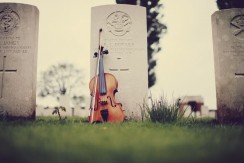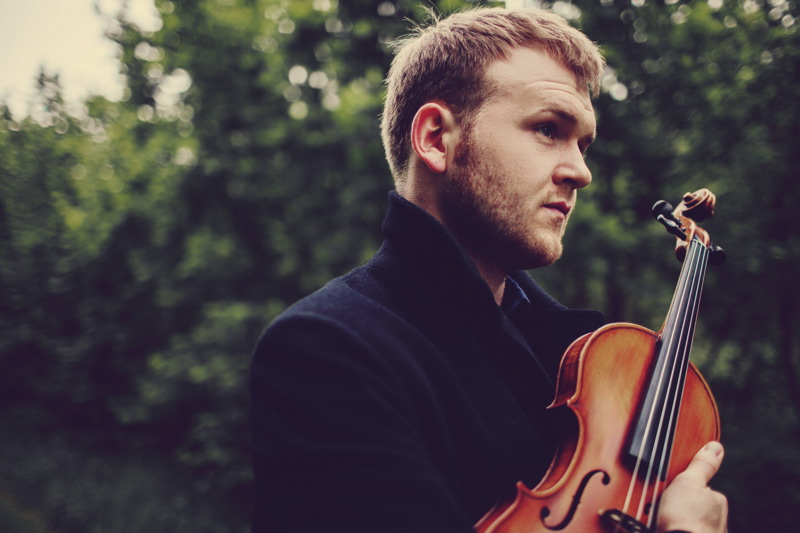Derbyshire-based Bellowhead fiddle player Sam Sweeney tells Big Issue North the remarkable story of the 100 year old Leeds-made fiddle that was never played until fate sent it his way, and of the man who made it. Sam Sweeney’s Fiddle: Made in the Great War is at Buxton Opera House, 14 Sept.
What’s the story of the violin made during the Great War in Leeds?
Nine or so years ago, I was fortunate enough to have some funding from the BBC to buy a new fiddle. I went to Roger Claridge’s fiddle shop in Oxford and tried loads of violins out that day. I instantly fell in love with one fiddle, bought it and took it home. The violin was clearly brand new – it had no marks of ever being played at all – but inside the fiddle there was a sticker saying “Made In The Great War” and another saying “Richard S Howard, No 6 Violin, Leeds, 1915”. It turns out that Richard Howard, a music hall performer and amateur fiddle maker, had carved the pieces of the fiddle but went off to war in Belgium before he could finish it off. He never came back to finish the violin off. Nearly a century later the pieces made their way into Roger Claridge’s hands and he finished the violin off, gluing it together, varnishing it and giving it a bridge and strings. The day he put it in his shop was the day I went in and fell in love with it. Quite unbelievable really, but a true story.
Do you feel it was your fortune to play it?
I can’t help feeling that there was a certain element of serendipity or fate involved. It all seems too coincidental really. What were the chances that I would choose to go to Roger’s shop on the day that he put the fiddle in window for the first time? I then picked the fiddle out of about 30 instruments that I tried. Anyone could have seen it and bought it and then not found out the incredible story behind it, but it happened to be me and my Dad picked up on the clue inside and followed it up to discover its amazing history. That can’t all be an accident, can it? It does make you wonder how many fiddles are out there being played with undiscovered stories as remarkable as mine.

You took the fiddle to the maker’s grave in Belgium. What was that experience like?
When I went over to Belgium to play at Richard’s grave, I took my dad and a film crew. I wasn’t really expecting it to hit me as hard as it did, but when we got there and I started playing the violin at the gravestone, everyone cried. It was like the whole story came full circle. It took nearly a century for Richard to hear the violin he never got to finish, and finally on a drizzly day last May I played to him for about three hours. The creation of the show up to that point hadn’t hit me emotionally. It had been exciting and a lot of hard work, but the poignancy and the scale of the story hit me all at once on that day in Woods Cemetery. I’ll never forget it. The footage of me playing at Richard’s grave features in the show too.
You’ve made contact with his family too. Were they aware of his story?
None of Richard’s family had a clue about any of this. They knew that he died in the war and that was pretty much it. Since my dad got in touch with them after he researched the story, they have learned so much about Richard and his life. About 15 of his relatives have been to see the show. The story has brought members of the Howard family together that had never met before. Some of them have been to Richard’s grave since we told them the story. It has been a remarkable journey, both for us and Richard’s descendants.
What does the show consist of?
The show is essentially a storytelling show with music and bits of film footage. The first half sets the scene with a few short stories and songs that relate to the second half. Then we come back after the interval and tell the story of Richard and his violin. The show is deeply tragic, but also humorous and uplifting in places. When the whole story comes full circle, it’s an amazing feeling every night we perform it. If you want to be deeply moved but also hear beautiful music and see one of the best storytellers in the country [Hugh Lupton], do come along. It might be your last opportunity to see it.
Before this discovery you played with Bellowhead. Did you have any ambitions then to create a performance piece with a narrative or do anything more theatrical?
When the story of the violin was first uncovered, I applied for a small amount of funding that was supposed to be for a one-night performance of the story with just me and Hugh Lupton. I then happened to meet the agent of a friend of mine who told me that story was simply too good to just perform once. I’m not a particularly ambitious person so it never occurred to me to do a tour of the show. My friend’s agent encouraged me to apply for a lot more funding from Arts Council England and our application was successful. We then had enough money to turn the show into a four-piece cast with lighting, projections and a sound engineer. Once that was all in place, we toured it last year for 23 nights and it was more than I ever thought this story would achieve. Now here we are again about to tour it for the second time.
Antonia Charlesworth



Leave a reply
Your email address will not be published.